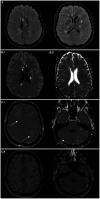Case report: Susac syndrome-two ends of the spectrum, single center case reports and review of the literature
- PMID: 38434197
- PMCID: PMC10904644
- DOI: 10.3389/fneur.2024.1339438
Case report: Susac syndrome-two ends of the spectrum, single center case reports and review of the literature
Abstract
Susac syndrome is a rare and enigmatic complex neurological disorder primarily affecting small blood vessels in the brain, retina, and inner ear. Diagnosing Susac syndrome may be extremely challenging not only due to its rarity, but also due to the variability of its clinical presentation. This paper describes two vastly different cases-one with mild symptoms and good response to therapy, the other with severe, complicated course, relapses and long-term sequelae despite multiple therapeutic interventions. Building upon the available guidelines, we highlight the utility of black blood MRI in this disease and provide a comprehensive review of available clinical experience in clinical presentation, diagnosis and therapy of this disease. Despite its rarity, the awareness of Susac syndrome may be of uttermost importance since it ultimately is a treatable condition. If diagnosed in a timely manner, early intervention can substantially improve the outcomes of our patients.
Keywords: Susac syndrome; black blood imaging; branch retinal arterial occlusion; hearing loss; neuroimmunology; stroke; vasculitis.
Copyright © 2024 Cviková, Štefela, Všianský, Dufek, Doležalová, Vinklárek, Herzig, Zemanová, Červeňák, Brichta, Bárková, Kouřil, Aulický, Filip and Weiss.
Conflict of interest statement
The authors declare that the research was conducted in the absence of any commercial or financial relationships that could be construed as a potential conflict of interest.
Figures




Similar articles
-
Susac syndrome: challenges in the diagnosis and treatment.Brain. 2022 Apr 29;145(3):858-871. doi: 10.1093/brain/awab476. Brain. 2022. PMID: 35136969 Review.
-
Long-term outcome in Susac syndrome.Medicine (Baltimore). 2007 Mar;86(2):93-102. doi: 10.1097/MD.0b013e3180404c99. Medicine (Baltimore). 2007. PMID: 17435589
-
Susac syndrome: neurological update (clinical features, long-term observational follow-up and management of sixteen patients).J Neurol. 2023 Dec;270(12):6193-6206. doi: 10.1007/s00415-023-11891-z. Epub 2023 Aug 22. J Neurol. 2023. PMID: 37608221 Free PMC article.
-
Susac syndrome - A review of current knowledge and own experience.Otolaryngol Pol. 2023 Jan 31;77(3):20-25. doi: 10.5604/01.3001.0016.2288. Otolaryngol Pol. 2023. PMID: 37772321 Review.
-
[Susac syndrome - an unusual syndrome which can be mistaken for multiple sclerosis].Lakartidningen. 2020 Feb 10;117:FSSS. Lakartidningen. 2020. PMID: 32045006 Review. Swedish.
References
Publication types
LinkOut - more resources
Full Text Sources
Medical

